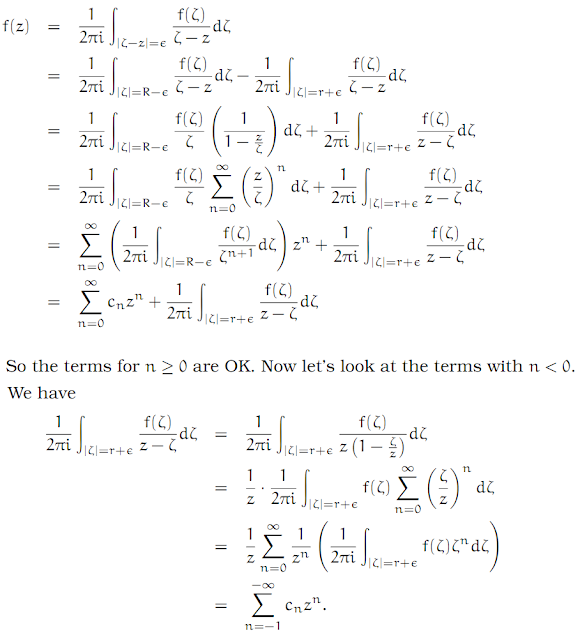Complex Analysis: #15 The Laurent Series
Since a pole of order n involves a function which looks somewhat like (z − z
0)
−n, at least near to the
singularity z
0, it seems reasonable to expand our idea of power series into the negative direction.
This gives us the Laurent series. That is, a sum which looks like this:
There is a little problem with this notation. After all, if the series is not absolutely convergent,
then we might get different sums if we start at different places in the doubly infinite sequence. Let
us therefore say that the sum from 0 to +∞ is the
positive series, and that from −∞ to −1 is the
negative series. So the whole series is absolutely convergent if both the positive and negative series are absolutely convergent.
[The negative series is called the “Hauptteil” in German, whilst the positive series is the “Nebenteil”.] One can obviously imagine that the negative series is really a positive
series in the variable 1/(z − z
0).
So given some collection of coefficients c
n for all n ∈ ℤ, let R ≥ 0 be the radius of convergence of
the series
That is to say, if 1/|z − z
0| < 1/r, or put another way, if |z − z
0| > r, then the negative series
converges.
Therefore, there is an open ring (or
annulus) of points of the complex plane, namely the region
{z ∈ ℂ : r < |z − z
0| < R}, where the Laurent series is absolutely convergent. In this ring, the function
defined by the Laurent series
is analytic. Note however that it is not necessarily true that f has an antiderivative. We see this
by observing that the particular term c
−1(z − z
0)
−1
has no antiderivative in the ring. On the other
hand, if we happen to have c
−1
= 0 then there is an antiderivative, namely the function in the ring
given by the Laurent series
Theorem 29
Assume the Laurent series converges in the ring between 0 ≤ r < R ≤ ∞. Let r < ρ < R.
The coefficients of the Laurent series are then given by
Proof
Since the series is uniformly convergent around the circle of radius ρ, we can exchange sum and integral signs to write
However, if we look at the individual terms, we see that if k ≠ n, then each term has an antiderivative,
and thus the path-integral is zero for that term. We are left with the n-term, and this is then simply
Conversely, we have:
Theorem 30
Given 0 ≤ r < ρ ≤ R, let G = {z ∈ ℂ : r < |z − z
0| < R} and f : G → ℂ be an analytic
function. Then we have f(z) = ∑ c
nz
n, (with n = −∞, . . ., ∞)
, where
Proof
For simplicity, choose z
0
= 0. Let z be given with r < |z| < R, and take ∈ > 0 such that
∈ < min{R − |z|, |z| − r}. Thus, according to theorems 5 and 6, we have
(Note that theorem 5 shows that the integrals for |z| = R − ∈, and for |z| = r + ∈ are equal to the integrals, taken along the path |z| = ρ.)
Theorem 31
Again, the same assumptions as in theorem 30. Assume further that there exists some M > 0 with |f(z)| ≤ M for all z with |z − z
0| = ρ. Then |c
n| ≤ M/ρ
n for all n.
Proof
Theorem 32 (Riemann)
Let a ∈ G ⊂ ℂ be an isolated singularity of an analytic function f : G\{a} → ℂ such that the exists an M > 0 and an ∈ > 0 with |f(z)| ≤ M for all z
0 ∈ G with z ≠ a and |z − a| < ∈ . Then
a is a removable singularity.
Proof
For then |c
n| ≤ M/r
n
for all 0 < r < ∈ , and therefore, for the terms with n < 0 we must have c
n
= 0, showing that in fact f is given by a normal power series, and thus it is also analytic in a.
Theorem 33 (Casorati-Weierstrass)
Let a be an essential singularity of the function f : G \ {a} → ℂ.
Then for all ∈ , δ > 0 and w ∈ ℂ, there exists a z ∈ G with |z − a| < ∈ such that |f(z) − w| < δ. (Which is to
say,
arbitrarily small neighborhoods of a are “exploded” through the action of f throughout ℂ, so that
they form a dense subset of ℂ!)
Proof
Otherwise, there must exist some w
0
∈ ℂ such that there exists an ∈ > 0 and |f(z) −w
0| ≥ δ for
all z ∈ G with |z − a| < ∈ . Let B(a, ∈) = {z ∈ ℂ : |z − a| < ∈ } and define the function h : (B(a, ∈ )\{a})∩G → ℂ
to be
Clearly h is analytic, with an isolated singularity at the point a. Furthermore.
Therefore, according to theorem 32 we must have a being removable. Thus, writing
we see that since the function given by 1/h(z) has at most a pole at a, we cannot have a being an
essential singularity of f. This is a contradiction.
As an example of a function with an essential singularity, consider the function f(z) = exp(1/z).
Clearly f is defined for all z ≠ 0, and not defined for the single point 0. In fact, 0 is an essential
singularity. To see this, consider the exponential series
The singularity at 0 obviously cannot be a pole of the function, since the negative series is infinite.
In fact we can make a theorem out of this observation.
Theorem 34
Let a function f be defined by a Laurent series ∑ c
n(z − z
0)
n, (with n = −∞, . . ., ∞), around a point z
0
∈ ℂ.
Assume that the series converges in a “punctured disc” {0 < |z − z
0| < R}. If infinitely many of the terms
c
n, for n < 0, are not zero, then z
0
is an essential singularity of f.
Proof
Obviously z
0
is not a removable singularity. If it were a pole of order n, then all the terms c
m,
for m < −n must vanish. The only remaining possibility is that z
0
is an essential singularity.






















































